Beebe Neighbors and City Clash Over Plans for New Police Station
By Ellen Putnam

The current Melrose police station
Last week, city officials and members of the Public Safety Facilities Advisory Committee (PSFAC) met with residents of the Beebe neighborhood to discuss the latest plans for the new police station, which is slated to be built on the site of the former Beebe School.
The construction of the new police station is part of the Public Safety Buildings Project, which Melrose voters chose to fund through a $130 million debt exclusion. This project has been under discussion for decades, with recognition among most residents that our current public safety facilities are inadequate for the needs of the Melrose Police Department (MPD) and the Melrose Fire Department. The debt exclusion passed with 60% of the vote in the November 2023 local election.
The Public Safety Buildings Project will involve the construction of a new police station on a new site as well as the renovation of all three fire stations. Phase 1 of the project will include constructing the new police station and renovating Engine 2, the fire station located on the corner of Tremont Street and Melrose Street.

The current police station is located in a former telephone switchboard building that was originally constructed in 1903. It is 7,000 square feet, and has a number of problems, including lack of ADA compliance and functional public areas, inadequate heating and cooling, insufficient desk and office space, and the absence of a number of facilities that are necessary or desirable in a modern police department.
In their July 2023 report, prior to the November vote, the Public Safety Building Committee identified the former Ripley School site in southeastern Melrose as “a viable and adequate site in Melrose for the new police station,” although its location, far from the center of town, was noted as a disadvantage. Construction of the new police station was estimated at $35.9 million.
Then, in September 2024, as planning for Phase 1 of the project was getting underway, the City of Melrose announced that they had shifted their focus to the Beebe School site, due to its more central location and an engineering evaluation that concluded that construction at the Ripley School site would require blasting ledge, for at least an additional $1.5 million.
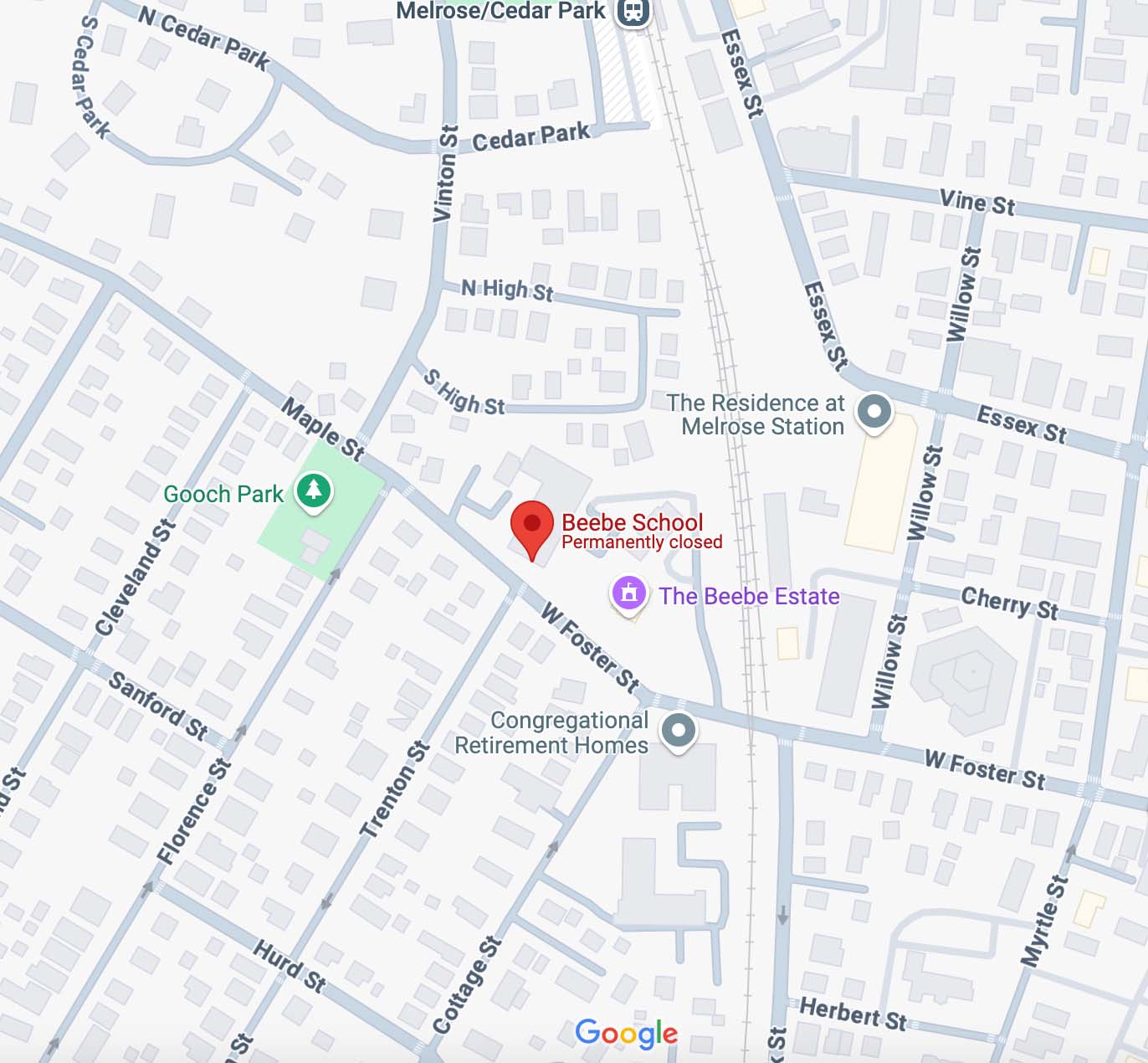
The Beebe neighborhood
Created with Google Maps
This change came as a surprise to many of the neighbors, who had not realized that the Beebe site was under consideration until the City announced its decision. Residents describe the neighborhood as very close-knit, and a group of over 40 people from 30 households formed to discuss and make their opinions about the plans heard.
“At each stage we engaged in the process,” explained Mike McLaughlin, who lives across the street from the Beebe School site, “not in opposition, but to be involved in what is going on. We all voted for the Public Safety Buildings Project, and we want to understand what is happening.”
“Our group has been told we have a reputation for being aggressive,” added neighbor Lisa Loveland, “but I have never seen anyone at any of these meetings be anything except very polite. We've just been asking very pointed questions.”

The former Beebe School
Last year, the City formed the Public Safety Facilities Advisory Committee (PSFAC) to provide Mayor Jen Grigoraitis and Project Manager Denise Gaffey with guidance on the project, although the mayor has the final say on all decisions. The City Council voted to appropriate funds for the design part of Phase 1, and will need to vote to approve bond purchases to fund the actual construction. The City held a public meeting in September to discuss the plans, and held two additional meetings for abutters in the fall.
Beebe abutters have spoken at public meetings throughout the process, including at School Committee meetings when the School Committee was voting on whether to officially retire the Beebe School, and City Council meetings where the City Council voted to accept the Beebe School and turn it over to the mayor’s office for City use. “We’ve been to every possible public meeting,” explained McLaughlin. “We testified every time we could. We’ve written several letters.”
In early January, members of the Beebe Neighbors United sent a letter that outlined three requests: reducing the size of the building by 20%; altering the design of the building's exterior to fit in better with the neighborhood; and installing geothermal energy.

Top: Initial design for the police station, presented at the public meeting in September
Bottom: Revised design for the police station, presented at the abutters' meeting in November
In response to this letter, Mayor Grigoraitis asked the architectural firm Dore + Whittier, which has been involved in planning for this project since 2017, to redraw plans to respond to the neighbors’ requests. Last week’s meeting was scheduled by the City to present the new plans and receive feedback from the neighbors.
Don Walter, a principal at Dore + Whittier, began by sharing that while two of the neighbors’ requests - the exterior design and geothermal energy - were on the table, size reduction was not.
The initial plans called for a police station that would be 31,000 square feet; early in his tenure, MPD Chief Kevin Faller reduced it to what is now 26,900 square feet in the current plans. “There has been a 13% reduction since the initial plans,” Walter explained. “20% would be 5,000 square feet. That’s more than just a couple of offices. It’s huge when you’re thinking about the size of the building.”
The police are “not going to walk in and fill every space,” Walter went on. “Projecting into the future, these are the spaces they require.”
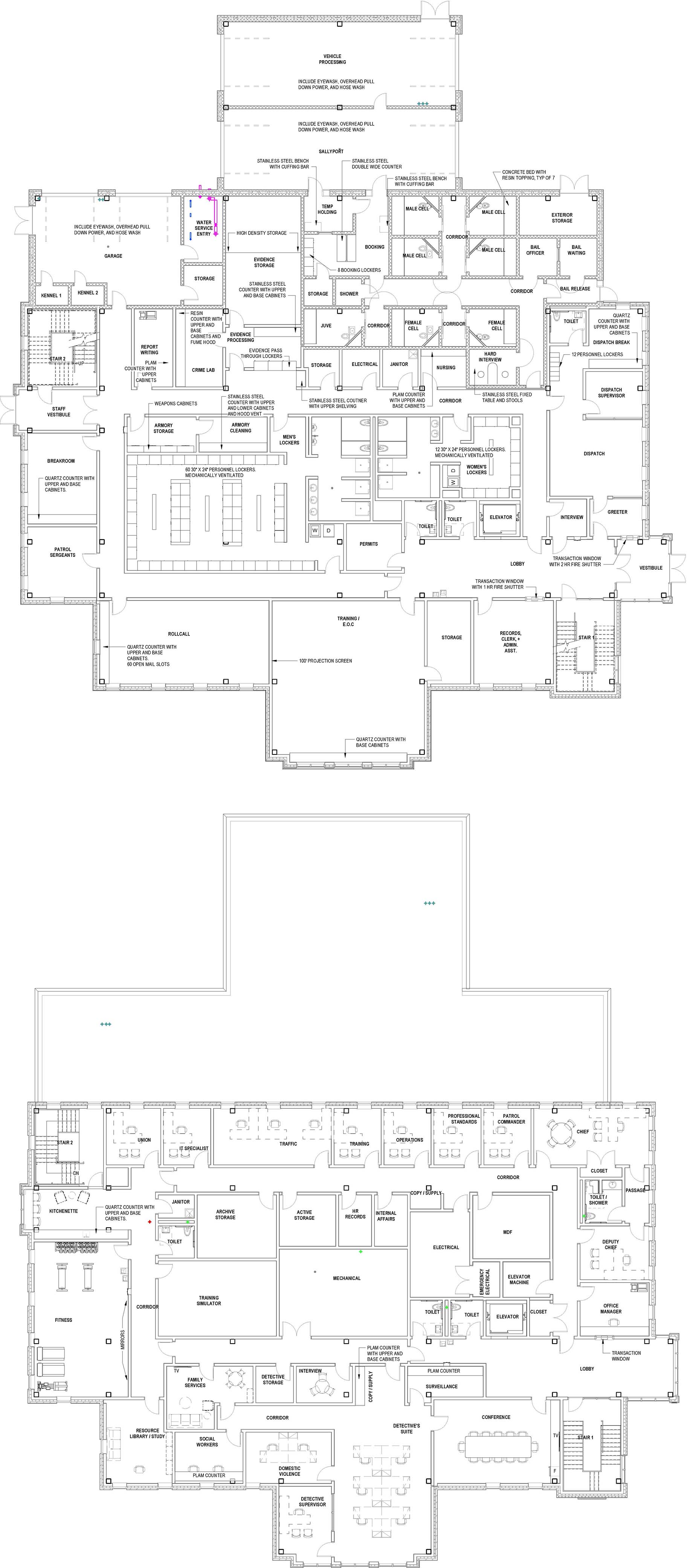
Floor plans for the police station, as presented at the abutters' meeting in November (Top: 1st Floor; Bottom: 2nd Floor)
Tom Dalton, the Communications Manager for the City of Melrose, shared that part of the reason for the disconnect between the current size of the MPD and the building plans is that the department's roster is “undersized for a community of this size.” Currently, the MPD is heavily reliant on overtime to meet staffing needs, which in some cases may actually be more expensive than hiring another full-time employee.
“You always build a little bigger than your current size in case you grow in the future,” added Dalton. “And a lot of the additional space is for operations and procedures that are hard to do in the current station: evidence storage, prisoner intake, training, things we don’t have any space for right now.”
“Trust me,” added Emmanuel Andrade, who is on the PSFAC and also lives in the neighborhood, “There is nothing you’re going to find in this building that is inflating the size of the station. It’s the size it needs to be. The reduction has been done.”
At the same time, neighbors are concerned that the planned size of the building, in addition to being too large for the neighborhood, may result in cost overruns that could affect the entire Public Safety Buildings Project. They have questioned the need for multiple holding cells, since arrests are infrequent in Melrose, and whether there need to be offices for positions that aren't currently filled. “They say they’re planning for 50 years,” reflected Loveland, “What the hell is the crime rate in Melrose going to be in 50 years, if this is the building we need?”
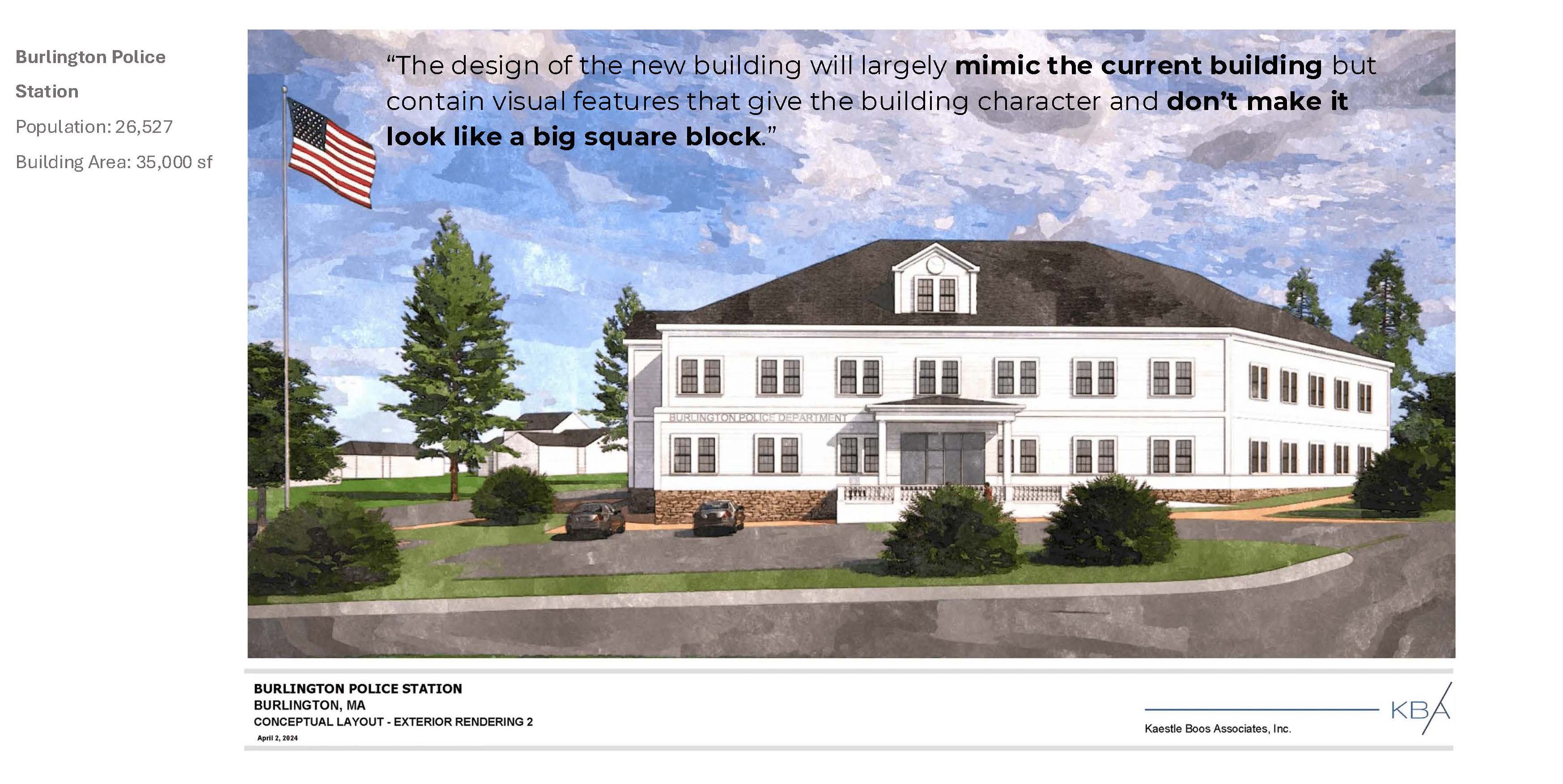
The Burlington Police Station, which is currently under construction. Neighbors identified this as a more appealing design than the initial plans for the Melrose station.
With regard to geothermal energy, PSFAC member and retired engineer Jim O'Loughlin noted that adding it to the project would require between $1 and $1.2 million of upfront capital, and could result in savings of $1.3 million over the lifespan of the building. Neighbors are asking for geothermal energy both for the environmental impact and to avoid loud HVAC equipment on the roof of the police station. The building's roof would be immediately behind the houses on South High Street, which is located on the ledge above the Beebe School site.
Project Manager Gaffey explained that because geothermal was not included in the original budget estimate, it would add to the cost, although construction alternates could be found to offset the cost. “We weren’t originally looking at geothermal because it’s expensive,” she explained. “The City had funding from the federal government to build the station as a net zero building,” which would have covered the costs of geothermal, “but now that funding is in jeopardy.”
Next month, a test well will be drilled on the Beebe School site to determine how many geothermal wells would need to be drilled in order to effectively heat and cool the building, which will then determine the overall cost of geothermal and whether it is feasible to add it.
In terms of the exterior design, neighbors described the plans from the initial meetings as a “fortress.” “It didn’t get a great reaction,” said Walter. “We heard that. We worked as a team with Denise and the police department: how can we make this building be a better fit in the neighborhood? How can we soften it up and make the building better?”
Walter presented four possible designs at last week’s meeting, although he noted that the two plans with a pitched roof would add an additional cost to the project of $700,000.
“These drawings are much better,” said one neighbor. “Someone was listening.”
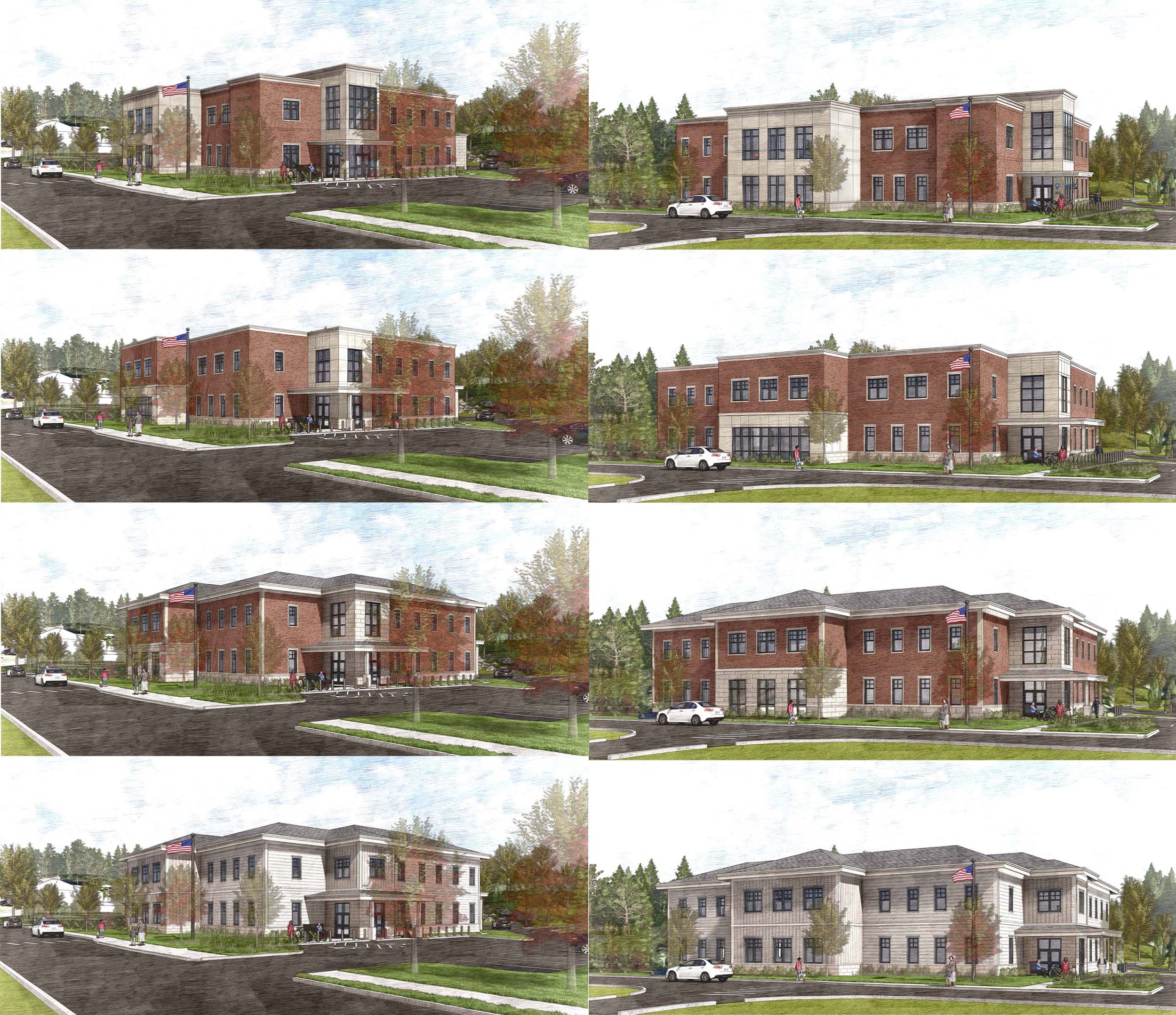
Top to bottom: four new design options, rendered from different angles
“I’ve probably been the most critical voice in this process,” added McLaughlin, “and this is the first time I feel like I’m being presented with things that reflect our requests.”
At the same time, Walter noted that the redesigns have been costly, at what he estimated to be $115,000 per month, and “it starts to add up quickly.” And with rising construction costs, “the longer it takes to go out to bid, the more the project costs.”
Some neighbors felt frustrated by what they heard as an accusation that they were the ones causing potential budget overages. “Had we been involved earlier,” said Elizabeth Kowal, who lives next door to the Beebe School site and was added to the PSFAC in the fall, “we would have been having these discussions earlier.”
Asked if there is actually room in the budget to potentially add geothermal and go with a more expensive but more attractive exterior, Gaffey said, “The mayor is very committed to prioritizing the interests of neighbors in terms of design changes. We want to make this a building that you feel more comfortable with.”
Some of the tension at last week’s meeting arose from the perception that the police station was not welcome in the neighborhood. Chief Faller noted that he had received correspondence that expressed displeasure with relocating the police station to the Beebe School site, and City Council President Leila Migliorelli, who was in the audience, confirmed that she had received similar correspondence.
However, those neighbors who were present at the meeting emphasized that they were not opposed to having the police station in their neighborhood. The Beebe Neighbors United group reached a consensus early on that they wanted and would welcome the police as their neighbors. “At every public opportunity,” Kowal stressed, “we have stated that we welcome the police station.” The management of the Levi Gould and Clarence Fuller Congregational Retirement Homes, which are across the street from the Beebe Estate, has also expressed its support for the project.
One neighbor recalled touring the current police station with her child's scout troop years ago. “I was shocked,” she said. “I couldn’t believe that was the facility the police were in. I hate to think that you think we don’t support you. We really do.”
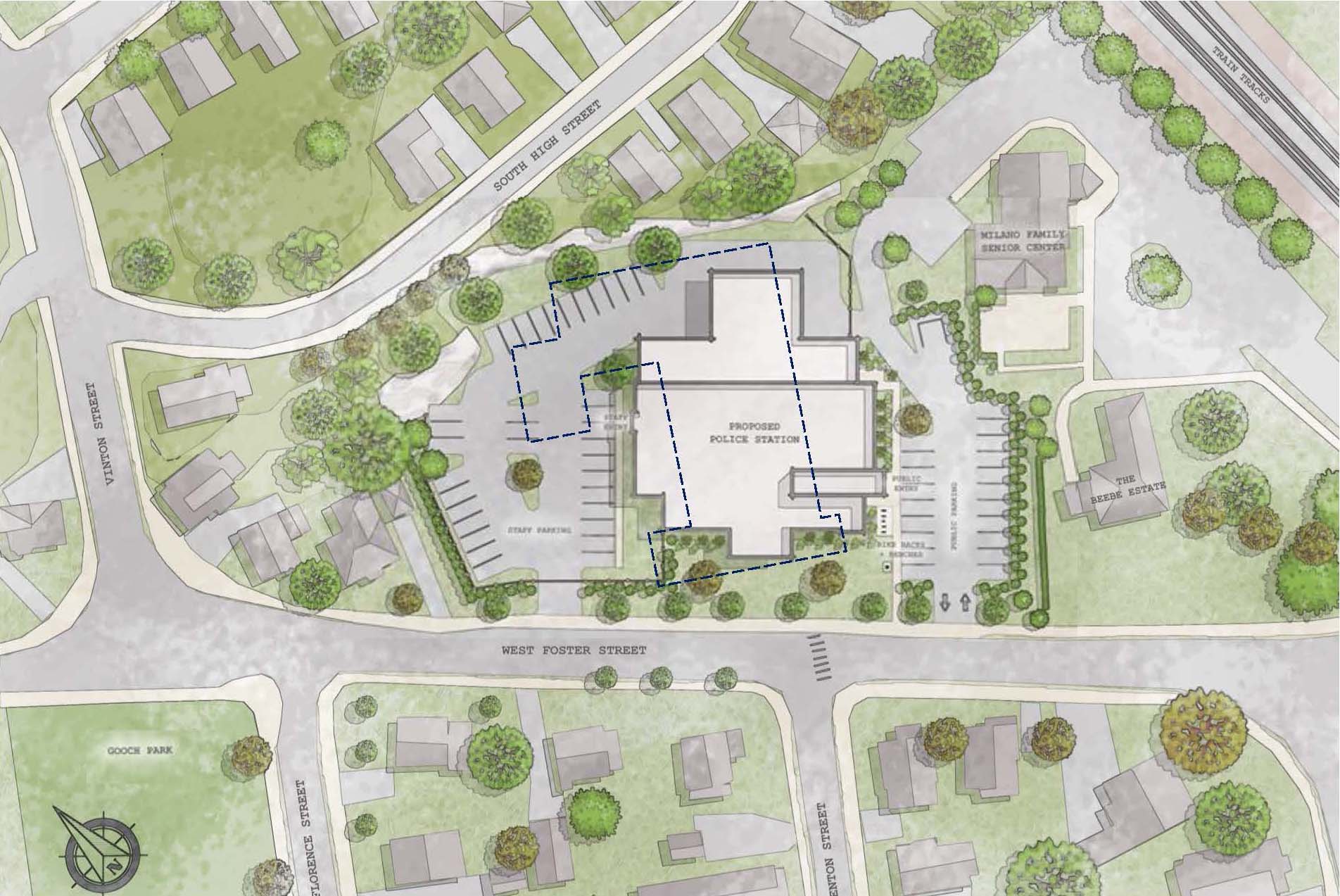
Site plan for the new police station
“Would it have been my dream to have the police station move into a residential neighborhood?” added neighbor Yael Mazor. “No, but it’s our job as neighbors to make room. To make a compromise for the good of the community. We’ve come at this in good faith, and the frustration you’re hearing is that we haven’t felt engaged in the process.”
In addition to feeling shut out of the process, Beebe neighbors shared that much of their concern and frustration comes from the larger financial issues that Melrose is currently facing. The School Committee and City Council have begun discussing the budget for Fiscal Year 2026 (which begins in July), and the City and public schools are currently facing an overall deficit of $6.1 million to maintain this year’s level of services. At the beginning of this month, Mayor Grigoraitis shared that she is looking into holding another override vote in November, after a previous override attempt failed last June.
“We want you to have the best police station possible,” shared Loveland, “but my daughter’s school is falling down around her. If this project goes over budget, it could put the request for an override in jeopardy.”
The funding for the Public Safety Buildings Project is not directly connected to the rest of the city budget, because it is contained within the $130 million debt exclusion that voters approved in 2023. This means that the city is allowed to levy more property taxes than they would otherwise be able to in order to fund payments on bonds for this specific project. However, this also means that the impact on residents’ property taxes will be an increase of approximately $600 per year for a home valued at $500,000 until 2060, when the bonds will be fully paid off. That increase may make some residents either less willing or less able to support a property tax override that would raise taxes further.
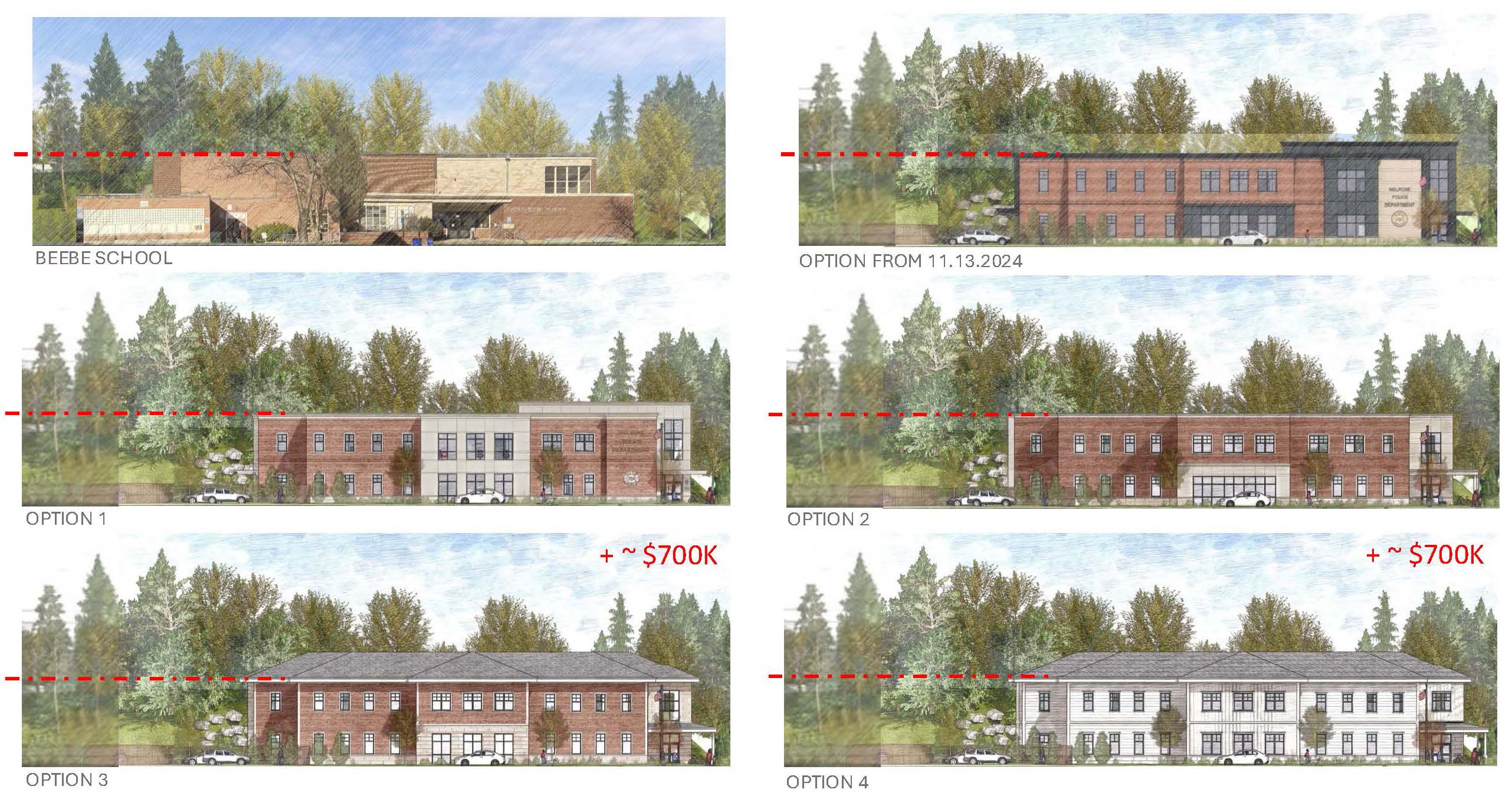
Elevations for different design options
Some residents also identified mistrust in the City’s financial management as a reason they did not support the last override attempt. “The scrutiny we have about the budget,” explained neighbor Rebecca McKensie, “is because we don’t want Melrose to be seen as a community that doesn't manage its money properly.”
“A world-class police station,” said Mazor, “that’s great, but our kids don’t have a world-class education. It’s hard to look at this in a vacuum. It’s not against the police, but we’re in a crisis.”
“There’s got to be a bigger picture look at what is going on in this town,” added Kowal. “The police station has all the bells and whistles, but your kid can’t have music or art. And sorry if that window collapses at the school.”
Despite the neighbors' concerns, city officials expressed their confidence that the project could be completed on time and on budget, without negatively impacting other city services. “I am looking forward to continuing to work towards providing the community and my officers the station that we deserve and need,” Chief Faller said in a statement, “while doing my best to ensure that the end product is on time, on budget, and meets our needs for many years to come. We have one shot to do this right and I am confident that we have the right team in place to achieve that.”
“People are angry about processes,” said Councilor Migliorelli, “but we're here to talk about the product. We need a little bit of trust. If they say a 20% reduction won’t work, then it won’t work. If they said they’ll keep it on budget, they’ll keep it on budget.”
“We’re willing to accept change,” Mazor reflected at the meeting's conclusion, “and we’re willing to compromise. We just want to feel like we have partners on the other side who are willing to compromise with us.”

Follow Us: